#Source Code Checker
Explore tagged Tumblr posts
Text
Accurate Code Plagiarism Detector for Developers

Designed for developers, Codequiry’s code plagiarism detector delivers accurate results to help identify copied or suspicious code in projects and assessments. It supports maintaining originality, whether in academic environments or professional development workflows. With precise detection and clear reporting, Codequiry is a trusted solution for educators, code reviewers, and engineering teams aiming to ensure authenticity and uphold high coding standards efficiently.
#code plagiarism checker#plagiarism checker#code plagiarism#source code checker#code plagiarism detector#detect code plagiarism#code similarity checker#website plagiarism checker#moss stanford#codequiry
0 notes
Text
So with the pandora's box of AI being released into the world, cybersecurity has become kind of insane for the average user in a way that's difficult to describe for those who aren't following along. Coding in unfamiliar languages is easier to do now, for better and worse. Purchasable hacking "kits" are a thing on the dark web that basically streamline the process of deploying ransomware. And generative AI is making it much easier for more and more people to obscure their intentions and identities, regardless of their tech proficiency.
The impacts of this have been Really Bad in the last year or two in particular. For example:
(I'm about to link to sources, and you better be hovering and checking those links before clicking on them as a habit)
Ransomware attacks have become increasingly lucrative for private and state-sponsored hacking groups, with at least one hack recently reported to have resulted in a $75 MILLION payout from the victim. This in combination with the aforementioned factors has made it a bigger and bigger risk for companies and organizations holding your most sensitive data.
In the US, the Salt Typhoon hack over the past year or so has compromised virtually all major phone networks--meaning text and phone calls are no longer secure means of communication. While this won't affect most people in day-to-day, it does make basically all the information you share over traditional phone comms very vulnerable. You should avoid sharing sensitive information over the phone when you can.
CISA updated their security recommendations late last year in response to this compromise. One of the recommendations is to use a separate comms app with end-to-end encryption. I personally prefer Signal, since it's open source and not owned by Meta, but the challenge can be getting people you know on the same service. So... have fun with that.
2FA is no longer as secure as it was--because SMS itself is no longer secure, yeah, but even app-based 2FA has been rendered useless in certain circumstances. One reason for this is because...
A modern version of the early-2000's trick of gaining access to people's accounts via hijacked cookies has come back around for Chromium browsers, and hackers are gaining access to people's Google accounts via OAuth session hijacking. Meaning they can get into your already-logged-in accounts without passwords or 2FA even being needed to begin with. This has been achieved both through hackers compromising chrome browser extensions, and via a reinvigorated push to send out compromising links via email.
Thanks to AI, discerning compromised email is harder now. Cybercriminals are getting better at replicating legitimate email forms and website login screens etc., and coming up with ways to time the emails around times when you might legitimately expect them. (Some go so far as to hack into a person's phone to watch for when a text confirmation might indicate a recent purchase has been made via texted shipping alerts, for example)
If you go to a website that asks you to double-click a link or button--that is a major red flag. A potential method of clickjacking sessions is done via a script that has to be run with the end user's approval. Basically, to get around people who know enough to not authenticate scripts they don't recognize, hackers are concealing the related pop ups behind a "double-click" prompt instruction that places the "consent" prompt's button under the user's mouse in disguised UI, so that on the second click, the user will unwittingly elevate the script without realizing they are doing it.
Attachments are also a fresh concern, as hackers have figured out how to intentionally corrupt key areas of a file in a way that bypasses built-in virus check--for the email service's virus checker as well as many major anti-virus installed on endpoint systems
Hackers are also increasingly infiltrating trusted channels, like creating fake IT accounts in companies' Office 365 environment, allowing them to Teams employees instead of simply email them. Meaning when IT sends you a new PM in tools like Zoom, Slack, or Teams, you need to double-check what email address they are using before assuming it's the real IT person in question.
Spearphishing's growing sophistication has accelerated the theft of large, sensitive databases like the United/Change Healthcare hacks, the NHS hack & the recent Powerschool hack. Cybercriminals are not only gaining access to emails and accounts, but also using generative AI tools to clone the voices (written and spoken) of key individuals close to them, in order to more thoroughly fool targets into giving away sensitive data that compromises access to bigger accounts and databases.
This is mostly being used to target big-ticket targets, like company CSO's and other executives or security/IT personnel. But it also showcases the way scammers are likely to start trying to manipulate the average person more thoroughly as well. The amount of sensitive information--like the health databases being stolen and sold on the darkweb--means people's most personal details are up for sale and exploitation. So we're not too far off from grandparents being fooled by weaponized AI trained off a grandchild's scraped tiktok videos or other public-facing social media, for example. And who is vulnerable to believing these scams will expand, as scammers can potentially answer sensitive questions figured out from stolen databases, to be even more convincing.
And finally, Big Tech's interest in replacing their employees with AI to net higher profits has resulted in cybersecurity teams who are overworked, even more understaffed they already were before, and increasingly lacking the long-term industry experience useful to leading effective teams and finding good solutions. We're effectively in an arms race that is burning IT pros out faster and harder than before, resulting in the circumvention of crucial QA steps, and mistakes like the faulty release that created the Crowdstrike outage earlier last year.
Most of this won't impact the average person all at once or to the same degree big name targets with potential for big ransoms. But they are little things that have combined into major risks for people in ways that aren't entirely in our control. Password security has become virtually obsolete at this point. And 2FA's effectiveness is tenuous at best, assuming you can maintain vigilance.
The new and currently best advice to keeping your individual accounts secure is to switch to using Passkeys and FIDO keys like Yubikeys. However, the effectiveness of passkeys are held back somewhat as users are slow to adopt them, and therefore websites and services are required to continue to support passwords on people's accounts anyway--keeping password vulnerabilities there as a back door.
TLDR; it's pretty ugly out there right now, and I think it's going to get worse before it gets better. Because even with more sophisticated EDR and anti-virus tools, social engineering itself is getting more complex, which renders certain defensive technologies as somewhat obsolete.
Try to use a passkey when you can, as well as a password locker to create strong passwords you don't have to memorize and non-SMS 2FA as much as possible. FIDO keys are ideal if you can get one you won't lose.
Change your passwords for your most sensitive accounts often.
Don't give websites more personal info about yourself than is absolutely necessary.
Don't double-click links or buttons on websites/captchas.
Be careful what you click and download on piracy sources.
Try to treat your emails and PMs with a healthy dose of skepticism--double-check who is sending them etc for stealthily disguised typos or clever names. It's not going to be as obvious as it used to be that someone is phishing you.
It doesn't hurt to come up with an offline pass phrase to verify people you know IRL. Really.
And basically brace for more big hacks to happen that you cannot control to begin with. The employees at your insurance companies, your hospital, your telecomms company etc. are all likely targets for a breach.
36 notes
·
View notes
Text
To the person sending Russian propaganda to my inbox:
I don't have the time or energy to debunk every single claim you made. And I think it would be harmful to help you spread disinformation without being able to research and verify all of it.
Regarding the whataboutisms though, you are absolutely right that the American government has done horrible things. You are also right that our schools will sugarcoat our history and gloss over aspects of it that reflect poorly on the country.
I will be the first to criticize our nation for its failings. For the wars in the Middle East. For past experimentations conducted on our citizens. For the racism and homophobia and transphobia that permeates our society and history. For the genocide committed against Native Americans. For so, so much!
I will stand here and proudly use my voice to condemn our government for its sins.
I would ask if you will do the same to Russia. No... I will ask if you can do the same.
In your ask, you say this...
You know what **I** hate about "leftists"? They follow American's propaganda and think everything Russia and China claims are lies.
But the fact is that there is a very simple reason for this...
Everything out of China and Russia is filtered through their governments. Going against their narrative is illegal. And the narrative is whatever is going to benefit them at the moment.
If the truth is beneficial, they will tell the truth. If a lie is beneficial, they'll tell a lie. And then they will declare the lie true, and make it illegal to fact check the lie.
Does the US government lie? Absolutely!
But we also have an independent media that, historically, has been able to call them out on their lies. This means there is at least some incentive for honesty. And we have the Freedom of Information Act that has allowed the media access to a lot of information that other governments would rather keep secret.
Mind you, the government isn't always honest. There will be cover-ups and we need to be vigilant against those. But generally speaking, the existence of a free media ensures that lying is usually counterproductive.
On the other hand, nothing Russia says can ever be trusted because without a media to hold their feet to the fire, they have no incentive to be honest about anything. It's not that everything they claim is a lie so much as everything they say will only be said to benefit them, and there is no incentive to be honest EVER when you ban the fact checkers and suppress everything else.
Do not forget that you have a state that not only calls lies truths, but arrests those who dare speak real truths.
Say what you will about America, but I can call out our government for the time being.
I can cite reliable sources that go against the government's narrative.
And I don't have to live in fear that challenging the government's narrative will get me locked up in prison like Dmitry Ivanov.
Even the outlet that I linked to above, Mediazona, has been blocked in Russia now.
Let me ask you this: If a truth inconvenienced the Russian government, do you trust that they would tell it to you anyway? If a lie was beneficial, would you trust that they wouldn't lie and suppress those who told the truth?
I am not a Russian citizen. So my knowledge of life in Russia is limited, as is my knowledge of life in Ukraine. So I will end this with the words of Dmitry Ivanov, a brave Russian citizen who is still serving an unjust sentence in a Russian prison for daring to speak truths that the Russian government would rather keep quiet.
Ivanov. I object to Article 207.3 of the Criminal Code itself because, while ostensibly prohibiting the dissemination of knowingly false information, the way this article has been applied in practice effectively bans the sharing of any information that does not come from official sources. Official sources, meanwhile, unfortunately do not communicate any information to us. Which I mentioned, because now the only sources of information I can use are official ones. It’s our television. I see the response that this approach to information evokes in our society. Total distrust of official sources, anxious anticipation and the spread of even the most unrealistic rumours among those who watch these news reports and try to read something between the lines. If reducing the spread of fake news were truly the legislator’s goal, it could be achieved simply by telling people the truth. However, this is a challenging path, as it would require admitting one’s own mistakes, explaining the causes of failures, and facing tough questions and criticism. Had Vladimir Putin chosen this approach a quarter of a century ago, there would be far fewer difficult questions to answer now...
#ukraine#russia#war#kyiv#Россия#москва#moscow#ukraine war#stand with ukraine#russian imperialism#invasion#russian invasion of ukraine#international politics#politics#global politics#world politics#kremlin#putin#vladimir putin#freedom of press
8 notes
·
View notes
Text
how to install dashboard unfucker (for desktop)
hi i use desktop and i use the dashboard unfucker extension by dragongirlsnout and you should too because it's awesome. i don't know much about computers so it was intimidating to set up but ended up being really easy.
but first:
what is dashboard unfucker?
dashboard unfucker is an extention that makes being on tumblr bearable again.
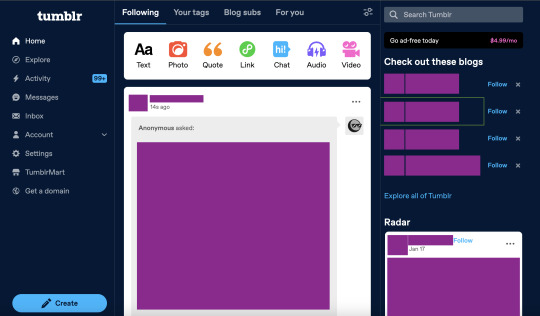
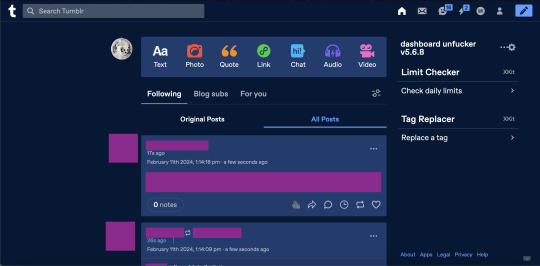
(ID: 2 screenshots of tumblr with urls/posts etc censored. the first is with the new layout, with labels on the left, the ad-free button, "check out these blogs," "explore all of tumblr," the radar, and no easy way to access your own blog. the second is with the extension enabled, the left hand side of the screen is empty, posts are wider, navigation icons are back at the top right, and the only thing on the right-hand side of the dash is the dashbaord unfucker and limit checker and tag replacer from xkit. end ID)
i got it for layout changes like these- the first is cramped and ugly and i feel like i'm on twitter. the second is warm and comfy and i can make my posts wider (i dont like all the empty space). (limit checker, tag replacer, and post color were done on xkit and palettes respectively, not unfucker, btw)
with the dashboard unfucker you can:
hide the following/blog subs/for you etc tabs
get rid of the changes/staff picks/etc carousel
hide recommended blogs and tags
add profile pics back to posts
hide the radar
hide the explore page
hide tumblr shop
hide user badges
highlight bots in ur activity feed
show who follows u in the activity feed
make posts wider/slimmer and move the dash posts position to the left/right
revert messages design (and make the messages box bigger)
revert activity feed to the old design
display vote counts on polls
show poll results without clicking (no more skewing polls or "see results"!!)
disable tumblr domains
add polls to reblogs
disable "post without tags?"
show ns.fw posts
and other things that i probably missed copying this from the settings!!
so how do you do it? it seems scary but it's easy actually. take my hand
(note: i did this on firefox and tested it on chrome, i'm not familiar with other browsers, also use firefox if at all possible fuck chrome)
how to install dashboard unfucker
step 1: install either tampermonkey, tampermonkey beta, greasemonkey, or violentmonkey (if you don't already have it)
note: im using tampermonkey as an example because it's what i use
step 2a: go to firefox extensions/chrome web store/your browser's equivalent
step 2b: look up "tampermonkey" and click "add to firefox/chrome/whatever" and confirm
step 2c: you're done! yayyy
step 2: click this link. look under "installation" where it says "Click on unfucker.user.js to install or update". and click that
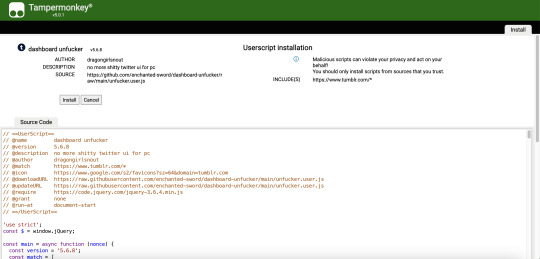
(ID: a screenshot of the tampermonkey install page, showing dashboard unfucker v5.7.8 installation information, the source code, and the install/cancel button. end ID)
(it should open in a new tab and look like this)
step 3: click install! (when i did this it didn't look like much happened and i got scared. dont get scared take my hand)
step 4: go to www.tumblr.com and to the right of the dash it'll have the dashboard unfucker label to the right!
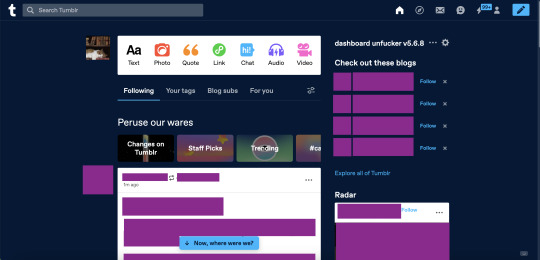
(ID: the default dash again, but with the dashboard unfucker title at the top right of the right-hand side of the dash. end ID)
step 5: click the little gear icon and all the options will pop up! u can fuck around with em to ur heart's content. i recommend exporting after ur done and saving it somewhere in case u have to uninstall/reinstall to troubleshoot or smth
you're done! now u can see the results of polls without clicking them and other such things
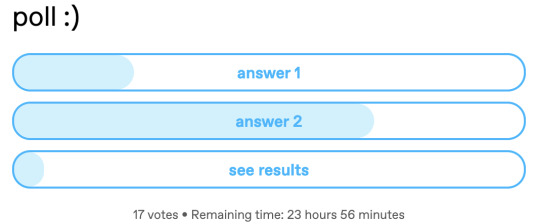
(ID: a poll i have not voted on. it has 17 votes and 23h 56m remaining. the title is "poll :)" and the answers are "answer 1" "answer 2" and "see results". there are no percentage labels, but the amount each answer has is indicated by light blue bars in each result, as they would be if i had voted. end ID) note: i'm not sure how/if this aspect of the extension is indicated for screenreaders
THIS POST IS TRANSGENDER BTW!
93 notes
·
View notes
Text
You can now get an Ad-Free, Tumblr-Live-Free version of the Tumblr Android app
I've been writing some Patches for the Tumblr app in the ReVanced framework, and they just got released in the ReVanced patches Pack, so you can install them too! No computer is needed, and everything is open source, meaning anyone can look at the code and verify that it's not malicious.
Patches
Disable Dashboard Ads (Currently not perfect - doesn't block blazed and doesn't block Tumblr's own "Sponsored" posts that aren't real ads, like the ones that are just a cat sitting in front of a Tumblr logo)
Disable Tumblr Live (Fully and forever!)
Disable "Enable notifications when this person posts" popup
Disable "You can send gifts to people" bubble
Disable the update checker (Tumblr annoys you to update if you're on an old version, who knew?)
Maybe more to come. Please suggest new ones!
Installation
I'm not good at writing beginner-friendly guides, so this one might be hard to understand if you're not a somewhat experienced user - there's already a bunch of guides for ReVanced, and they have a support discord where you can ask for help. I encourage anyone to write a better guide for this.
First we need to download and install the ReVanced Manager. You can get it here: https://revanced.app/ Just download and install the APK.
Just like with any android app download that doesn't use the Google play store (or similar stores), you'll get some warnings that the file could be dangerous (since it's an app installer package), and you'll likely have to give your browser or File explorer permissions to install apps.
Next, we'll need a Tumblr APK to patch it. We usually can't use your already installed Tumblr since it's a Split-APK, and ReVanced doesn't really support those. Get one from APKMirror (preferred) or alternatively from APKPure (often doesn't have all app versions). Make sure you're selecting the download to a normal APK, not a Split-APK/XAPK. Also probably don't download a version that has alpha or beta in the name.
If you downloaded the Tumblr apk, don't install it. Open the ReVanced Manager we installed earlier, click Patcher->Select an Application->Storage (bottom right)->Pick the Tumblr APK you just downloaded.
Now you can de-select patches if you want, but the default is fine, it includes all patches made for Tumblr. Then click Patch in the bottom right and wait for it to finish. Before you install the patched Tumblr, you'll have to uninstall the old Tumblr since they have the same package name but our patched one isn't signed by the Google Play Store. So uninstall the Tumblr app now (and probably save/reblog this post if you're on your phone right now so you don't lose it), then switch back to the Manager and click Install to install the patched app.
Yay, now you have patched Tumblr. Everything should work as normal otherwise. If you're reading this in the (far) future and Tumblr ever updated the app and broke the patches and no one updated them to work with newer versions, you can use an old Tumblr APK and it should keep working forever. Right now, I am using v31.5.0.110 and everything is working fine.
Tell me (asks/dms/rbs) if anything is broken or you have more ideas for patches I could add. I have like 10 followers so no one is gonna see this without reblogs. Oki bye!
96 notes
·
View notes
Note
Is that "evil fact checker" user that's constanly appear under your post an actual person or some AI. Their whole thing just seems to be ask to chat tp wich i'm not sure if is reliable.
Essentially what they do is a type of prompt and to chat GPT normally have the program answer everything for them. Except they've attempted to make an argument saying that chat GPT does not get its information from CNN or other sources. Which is factually inaccurate because a lot of the sources that chat GPT uses is based on scraping data from websites that get their news from CNN and other similar sources.
And that's the point. Chad GPT isn't even an ai. It is a machine learning program that gets the bulk of its information from scraping a variety of different sources. A lot of those sources, get THEIR sources from said mainstream sites. What's even more important is that chat GPT can be convinced to change its opinion on something based on you telling it to. Also, this not counting the fact that you can code inject into it. So it can be smug as he wants to be, all the while being factually incorrect.
2 notes
·
View notes
Text
Meta’s fact-checking partners claim they were “blindsided” by the company’s decision to abandon third-party fact-checking on Facebook, Instagram, and Threads in favor of a Community Notes model, and some say they are now scrambling to figure out if they can survive the hole this leaves in their funding.
“We heard the news just like everyone else,” says Alan Duke, cofounder and editor in chief of fact-checking site Lead Stories, which started working with Meta in 2019. “No advance notice.”
The news that Meta was no longer planning on using their services was announced in a blog post by chief global affairs officer Joel Kaplan on Tuesday morning and an accompanying video from Meta CEO Mark Zuckerberg. Instead, the company plans to rely on X-style Community Notes, which allow users to flag content that they think is inaccurate or requires further explanation.
Meta partners with dozens of fact-checking organizations and newsrooms across the globe, 10 of which are based in the US, where Meta’s new rules will first be applied.
“We were blindsided by this,” Jesse Stiller, the managing editor of Meta fact-checking partner Check Your Fact, tells WIRED. His organization started working with Meta in 2019, and it has 10 people working in the newsroom. “This was totally unexpected and out of left field for us. We weren't aware this decision was being considered until Mark dropped the video overnight.”
The news organizations who had partnered with Meta to tackle the spread of disinformation on the platform from 2016 are scrambling to figure out how this change will impact them.
“We have no idea what the future looks like for the website going forward,” Stiller says.
Duke says Lead Stories has a diverse revenue stream and most of its operations are outside of the US, but he claims the decision would still have an impact on them. “The most painful part of this is losing some very good, experienced journalists, who will no longer be paid to research false claims found on Meta platforms,” Duke says.
For others the financial implications are even more dire. One editor at a US-based fact-checking organization that works with Meta, who was not authorized to speak on the record, told WIRED that Meta’s decision “is going to eventually drain us out.”
Meta did not respond to a request to comment on its partners’ allegations or the financial impact its decision would have on some organizations.
"Meta didn’t owe fact-checkers anything, but it knows that by pulling this partnership it’s removing a very significant source of funding for the ecosystem globally,” says Alexios Mantzarlis, who helped establish the first partnerships between fact-checkers and Facebook between 2015 and 2019 as director of the International Fact Checking Network.
Meta’s partners were also angered by Zuckerberg’s allegation that fact-checkers had become too biased.
According to Duke, it is disappointing to hear Mark Zuckerberg accuse the organizations in Meta's US third-party fact-checking program of being “too politically biased.” “Let me fact-check that. Lead Stories follows the highest standards of journalism and ethics required by the International Fact-Checking Network code of principles. We fact-check without regard to where on the political spectrum a false claim originates.”
This was a viewpoint reiterated by Kristin Roberts, the chief content officer at Gannett Media, whose publication USA Today was another Meta fact-checking partner.
"Fact-based journalism is what USA Today does best,” Roberts said in an emailed statement. “Truth and facts serve everyone—not the right or the left—and that's what we will continue to deliver.”
Many of Meta’s fact-checking partners have claimed that Zuckerberg blaming fact-checkers for over-the-top censorship on the company’s platform was inaccurate, as they simply added information and context to posts, leaving the final decision to take down content to Meta itself.
“To blame fact-checkers is a disappointing cop-out, and it perpetuates a misunderstanding of its own program,” says Neil Brown, the president of the Poynter Institute, which owns PolitiFact and the International Fact-Checking Network. “Facts are not censorship. Fact-checkers never censored anything. And Meta always held the cards. It's time to quit invoking inflammatory and false language in describing the role of journalists and fact-checking.”
Other fact-checkers point out that the Community Notes model, which has in the past worked poorly at X, still requires the input of experts in order to work.
“While a crowdsourced model for content verification may work in theory, it cannot magically succeed without relying on expertise, particularly on complex scientific and technical topics,” Emmanuel Vincent, the executive director of Science Feedback, a Meta fact-checking partner, tells WIRED. “Participants in such a program will still need to rely on credible evidence sourced from fact-checking organizations, trustworthy journalism, or scientists with relevant expertise to ensure accurate assessments.”
Zuckerberg, who mentions president-elect Donald Trump on a number of occasions in his video, has been trying to build closer links to the incoming administration in recent weeks.
The Meta CEO, who donated $1 million to Trump’s inauguration fund, was a recent visitor to Trump’s Mar-a-Lago resort, bringing with him a pair of the company’s Ray-Ban AI glasses as a gift.
Zuckerberg’s decision last week to promote Kaplan, a former deputy chief of staff to President George W. Bush, was widely seen as an effort to appease the incoming administration—as was Meta’s decision this week to appoint UFC CEO and close Trump ally Dana White, to its board.
Now some of Meta’s fact-checking partners see the decision to abandon third-party fact-checkers and implement an X-style Community Notes model as another effort to appease Trump.
“It’s unfortunate that this decision comes in the wake of extreme political pressure from a new administration and its supporters,” Angie Drobnic Holan, director of the International Fact-Checking Network, said in an emailed statement. “Fact-checkers have not been biased in their work—that attack line comes from those who feel they should be able to exaggerate and lie without rebuttal or contradiction.”
2 notes
·
View notes
Text
Future Trends in Java Code Plagiarism Detection

Detecting plagiarism in Java code requires cutting-edge technology. Codequiry’s Code Plagiarism Checker Java stands out by offering AI-driven insights, live checks, and detailed reports. Emerging trends in plagiarism detection emphasize real-time feedback and secure traceability, positioning Codequiry as the preferred tool for educators and developers committed to preserving originality in the fast-evolving Java programming landscape.
#Code Plagiarism Checker Java#Code Plagiarism Checker For Java#code plagiarism checker#plagiarism checker#code plagiarism#source code checker#detect code plagiarism#code plagiarism detector#code similarity checker#codequiry#website plagiarism checker
0 notes
Text
December update
Happy holidays everyone!
I'm going to change up this monthly update a little, since cost is very much not an issue anymore. I'll still give a quick overview, but it's mostly going to be just a status update of how the re-work is progressing.
You have likely already seen the Tumblr becoming more active again this month, with flash sales being posted as well as dominance results. Work is slowly progressing on getting stuff back up and running.
Below the cut is a bunch of information, but give it a quick read!
The total cost in December was €8.22 post VAT. Essentially, the singular €10 patreon I have covers this entire cost and then some. The cost will likely go up again, a little bit, once the database and storage gets used more as I add stuff. But the major money sink of the website itself is gone now, so there's that!
On that note, I had said that I would stop accepting patreon payments 1st of january, but now that the toolset has made a re-start I'll let the decision fall down to the person that is currently part of it if they wish to continue supporting me.

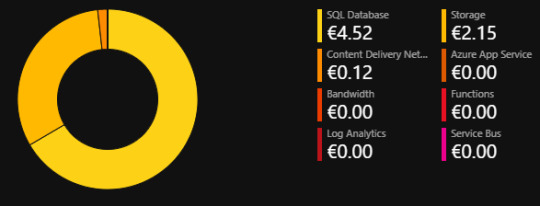
The new way of hosting the tools using Azure Functions is proving to be very valuable, even though nothing I had made was inherently compatible. So I've been slowly working on completely rewriting the entire toolset, which has come with many challenges and many learning opportunities to say the least.
Tumblr
On the Tumblr side of announcements everything is up and running, it's basically back to how it was. It's also the place where I've had the most interaction with users so it was a semi-priority to get this back up first.
Site/Skin Tester
This entire toolset started its life as a simple skin previewer for my girlfriend so she could sell her skins easier without spending hours providing manual previews to interested folks. Strangely enough, this has now become a much lower priority. The nature of the idea behind a previewer however is something I can definitely build into the ecosystem of Azure Functions.
What I will likely end up doing first though is add a barebones 'site' that will allow things such as the code snippets to be used (the little scripts that allowed things such as coverage checker, color wheel, etc).
Discord
The Discord side however is my next target, some of you might have already noticed either because I have been sharing stuff or you just keep an eye on the source code behind FRTools on GitHub.
My goal with Discord is to make everything work the way it was, to some extend. There are things I cannot do with my new planned setup. The 'Bot' is no longer a 'Bot' that is ever present, instead I am leveraging Discord's /slash command system. This allows me to build a bot that functions as a bot but is not online 24/7. It just gets spun up to handle a command and goes afk again.
Just now I've finally finished the first command to be fully functional, it allows looking up the information of a dragon either by URL (pictured below) or simply by ID.
So there you have it!
13 notes
·
View notes
Text
Introducing Codetoolshub.com: Your One-Stop IT Tools Website
Hello everyone! I'm excited to introduce you to Codetoolshub.com, a comprehensive platform offering a variety of IT tools designed to enhance your productivity and efficiency. Our goal is to provide developers, IT professionals, and tech enthusiasts with easy-to-use online tools that can simplify their tasks. Here are some of the tools we offer:
Base64 File Converter
Basic Auth Generator
ASCII Text Drawer
PDF Signature Checker
Password Strength Analyser
JSON to CSV Converter
Docker Run to Docker Compose Converter
RSA Key Pair Generator
Crontab Generator
QR Code Generator
UUID Generator
XML Formatter
And many more...
We are constantly updating and adding new tools to meet your needs. Visit Codetoolshub.com to explore and start using these powerful and free tools today!
Thank you for your support, and we look forward to helping you with all your IT needs.
2 notes
·
View notes
Text
I had an odd dream the other night, in which there was a fanfic website that was dedicated to taking the concept of the gift economy way too far.
So, at first glance, the site looked fairly normal. It took the open-source code from AO3 and based itself off of that, though the default site skin was dark pink comic sans on a light yellow background. The difference was that there was an in-site way of commissioning authors. Not for money - the site was as against monetizing fanfic as the average (reasonable) fanfiction website is.
Instead it had something called either CommentBux or FicBux (I'll use the latter from now on bc that's shorter). You'd earn one FicBux if you left a kudo on the author's work, and another FicBux for every 10 words you left in a comment. There was a plagiarism checker so you couldn't just quote the fic when commenting, emojis didn't count, and I'm not sure if words rolled over from one comment to the next. FicBux were separated by each author, because they were used for commissions.
10 FicBux = 100 words that you could commission from the authors. Authors couldn't turn commission requests off, but they could
Change "prices" from the default.
Report harassing commissioners.
Reject commissions.
Accept requests and refund them later (but not after publishing!), but there was a 3-day wait time between doing so.
Set it so that readers couldn't request fandoms, characters, ratings (not rated wasn't an option on the website), relationships, archive warnings, or additional tags beyond what you had already written.
Readers, on the other hand, could report authors for not writing what was requested (within reason, which is to say the staff/volunteer got to decide what they wanted). They could also cancel the commission any time before the author finished, but they then couldn't request from that author for another 7 days.
Authors wouldn't be able to publish a commissioned fic until they reached the word count, but they could offer a partial refund. However, the commissioner would have to accept this before the author could publish. If an author went more than 33% over the paid word count, a warning would pop up, and if they went more than 66% of the paid word count they couldn't publish the fic.
Due to the way the site was putting the economy into the gift economy, they got rid of prompt memes and gift exchanges as well as regular old gifts for non-"paying customers". Sure, you could write in your author's note that this was a fic written for your friend Alice's birthday without actually gifting it to her because she didn't pay you, but it was frowned upon.
#fanfiction#fanfic#writing#writeblr#i know i say take the concept way too far but a small part of me hopes someone makes this concept a reality#now is it watching the torment nexus crash and burn while i eat popcorn from the sidelines#or is it a new age of fandom (especially since as much as i love AO3 i don't want it to be the only popular site in case something happens#(no ffn webnovel and wattpad don't count))#but i am generally leaning towards 'no please don't make this what horrific ideas am i releasing upon the world'
5 notes
·
View notes
Text
Top AI Chatbots: Meet ChatGPT and Other Standouts!

The integration of artificial intelligence into our daily lives is evident in various aspects, from using facial recognition to unlock our smartphones to commanding virtual assistants like Alexa to play music. Now, AI has expanded its capabilities to encompass our writing tasks as well.
AI chatbots can now alleviate the burden of writing daunting papers, coding, composing emails, creating art, and even assisting with MBA exams with a simple command.
While ChatGPT has gained significant attention in this field and even launched a free mobile app for iPhones, its immense popularity has resulted in frequent capacity issues, rendering it unreliable for day-to-day usage.
Fortunately, there are several other highly capable AI chatbots available that ensure accessibility whenever you need assistance.
To help you make an informed decision regarding your next writing assistant, I have compiled a comprehensive list of the top AI chatbots and AI writers currently available in the market.
This list provides detailed information about each option, equipping you with the necessary knowledge to select the most suitable writing assistant. One notable contender is the new Bing, which boasts exceptional sourcing abilities, internet access, and an advanced LLM model.
The new Bing: The new Bing AI chatbot, powered by OpenAI's advanced LLM model, offers exceptional capabilities. It functions as a search engine, providing real-time information on current events. With its free accessibility, Bing stands out as a convenient alternative for users.
ChatGPT: ChatGPT, developed by OpenAI, is a widely recognized AI chatbot known for its impressive writing skills and conversational abilities. It excels in generating text, solving math problems, and assisting with coding. While occasionally reaching capacity due to high demand, a paid subscription option, ChatGPT Plus, ensures unrestricted access.
Perplexity AI: Perplexity AI, equipped with GPT-3 and GPT-4, offers free access to its services. With a seamless integration to the internet and real-time events, it serves as a valuable source of information. Perplexity AI's user-friendly interface enhances the overall experience, making it an attractive option.
Jasper: Jasper is an advanced language processing tool that utilizes OpenAI's GPT-3.5. It excels in generating human-like responses and offers a range of writing templates, copyediting features, and a plagiarism checker. Although it comes at a higher cost, it provides enhanced productivity and quality for businesses.
YouChat: YouChat, powered by GPT-3, offers free access and leverages Google sources for its responses. It provides a comprehensive list of sources, making it valuable for those seeking credible information. Its availability and source citing capabilities set it apart from other chatbots.
Chatsonic by Writesonic: Chatsonic, supported by Google, offers up-to-date information and excels in text editing. It provides a free trial and offers AI image generation. However, it comes with a subscription cost depending on word count requirements.
Google Bard: Google Bard is an experimental chatbot powered by Google's LaMDA. While it may not excel in coding or search engine functionality, it proves proficient in text editing and generating professional documents. Google Bard is completely free to use.
Socratic by Google: Socratic, designed for students, provides instant responses to educational questions with engaging visuals. It offers a worksheet scanning feature for curated answers. Although it has limitations, such as not writing full essays, it serves as a useful tool for students.
Conclusion
Choosing the right AI chatbot depends on individual requirements and preferences. The new Bing stands out for its outstanding performance and accessibility. Other options like ChatGPT, Perplexity AI, Jasper, YouChat, Chatsonic, Google Bard, and Socratic cater to specific needs and offer various features.
Exploring these AI chatbots provides users with a range of options to enhance their writing experience.
2 notes
·
View notes
Text
I feel like there are two separate phenomena here.
The first is people expecting computers to be infallible. You wouldn't accuse a calculator of making a math error, right? This is what leads to people confidently citing nonexistent sources that ChatGPT made up with the same confidence they would cite a case they found using Google Scholar; it simply didn't occur to them that the machine could be wrong in that way. Given that grammar and spelling are almost simple enough formal systems that we can automate them, and grammar/spelling checkers are usually right (especially if you're a kid who makes a lot of basic mistakes), it's not surprising people might make this mistake.
The second is expecting computers to be more convenient than people, to be faster or cheaper or whatever. This is IMO much more defensible when it comes to LLMs, which genuinely can be more convenient than doing a task yourself or finding a person of equivalent skill to the LLM, but it can also definitely be a trap. Similarly, as a programmer, the instinct to try and automate tasks can be a good one but can also lead to wasting more time debugging your code than it would have taken to do the task by hand.
I occasionally use LLMs for stuff that you could arguably describe as brainstorming. LLMs are pretty good at giving you generic lists of things, helping you find words in a very specific category, stuff like that. Sometimes these are questions I could pose to a human, but I don't want to waste their time or I can't be bothered to walk to the next room. Sometimes they aren't. Maybe I have already asked a human if they can think of this word that's on the tip of my tongue and they couldn't, nor could Google, but ChatGPT can. (Or sometimes it can't, but it's worth a try.) Or maybe nobody I know speaks the languages involved, or whatever.
Okay. It's time for an AI rant.
My nephew is 13 years old. Whenever he writes a paper for school, I check it over and fix all of his mistakes for him. He said to me, "Maybe I'll proofread your paper for you in exchange," meaning one of the scholarly articles I write for work. I said, "Cool," and gave him the file. And he said, "Well, this is full of errors! See, you always say you have a lot to correct on my stuff, and look at all the stuff you got wrong!" And I said, surprised, "What? Where?" Because I'm sure there are typos in the draft I sent him, but not, like, that many.
And then he pointed to the screen and said, "Look at all the blue and red lines you have."
And I said, "Yeah, but those are wrong. Like, those are blue and red lines I'm ignoring because the computer is wrong." And then I paused and added, "You know you can't proofread a paper by just looking at the red and blue lines, right?" And he gave me the blankest look, because that clearly is EXACTLY what he thinks. And it became even clearer suddenly why, whenever I correct something on his paper, his immediate reaction is, "It didn't have a blue or red line."
There's a very good reason for that: THAT'S BECAUSE THE COMPUTER ISN'T SMART ENOUGH TO KNOW THAT IT WAS WRONG.
I am so tired of being sold the idea that computers are better than humans and so we should just outsource everything to them, which is clearly the lesson my nephew is absorbing in U.S. middle school. COMPUTERS ARE NOT BETTER THAN HUMANS. Like, maybe they are better at humans at crawling through rubble to find people trapped inside. They are also better at preserving things in a searchable format. Things like that. Very limited circumstances.
I don't want to sound alarmist but everything I hear about people using generative AI freaks me out. It's not just that I'm freaked out by people being like, "I use it to write novels!" (Although I don't see how they do, I have tried to have it write fiction for me and the output was truly terrible.) But I recognize my bias around creative writing and so no one needs to credit my views on artificial writing. But! Other things are alarming, too! "I use it to brainstorm x, y, or z." But...why? Why not just...use your own brain...to...brain...storm? The computer doesn't even have a brain to brainstorm with! And you might be like, "But it comes up with things that my brain would never think of!" So would other people! You could also brainstorm with other people! Or even through Google to see what other people have thought before you (not AI). Please don't belittle the wonder of thinking.
I just feel like the marketing around generative AI boils down to "Wouldn't it be easier not to use your own brain to think about things?" Everyone. No. It would not be. Please just trust me on this. I'm not just an old person who is out of touch with technology or something. I promise. USE YOUR BRAINS. IT WILL BE OKAY.
46K notes
·
View notes
Text
Host Header Injection in Symfony Explained: Risks, Exploits & Fixes
Host Header Injection is a subtle yet critical web vulnerability that developers often overlook—especially in modern frameworks like Symfony. In this blog post, we’ll explore what Host Header Injection is, how it can be exploited in Symfony applications, how to prevent it, and how you can test your own website using our website vulnerability scanner online free.

This article includes coding examples, screenshots, and references to help you fully understand the impact and defense mechanisms.
👉 You can find more blogs like this on our official blog portal at Pentest Testing Corp.
🕵️♂️ What is Host Header Injection?
Host Header Injection occurs when a web application uses the value of the Host header in an unsafe way—without validation or sanitization. This can lead to:
Web cache poisoning
Password reset poisoning
Misrouting to malicious domains
Bypass of security mechanisms
Symfony applications are susceptible when routing logic or URL generation depends on the Host header.
🚨 Real-World Exploit Scenario in Symfony
Here’s an example to show how this could become a problem:
Symfony supports generating URLs via the generateUrl() method. If improperly configured, it can trust the Host header.
Consider this controller code:
// src/Controller/ResetController.php use Symfony\Component\Routing\Generator\UrlGeneratorInterface; public function resetPassword(Request $request, UrlGeneratorInterface $urlGenerator) { $userEmail = $request->get('email'); $user = $this->getUserByEmail($userEmail); $token = bin2hex(random_bytes(32)); $resetUrl = $urlGenerator->generate('reset_password', ['token' => $token], UrlGeneratorInterface::ABSOLUTE_URL); mail($user->getEmail(), "Reset Your Password", "Click here: $resetUrl"); }
Now, if the Host header is spoofed (e.g., evil.com), then the generated link becomes:
https://evil.com/reset-password?token=abc123
📌 The attacker now has full control over the reset link sent to the user!
🧪 How to Reproduce Host Header Injection in Symfony
You can test this vulnerability using curl:curl -H "Host:
evil.com" https://your-symfony-app.com/forgot-password
Or via Burp Suite by intercepting and modifying the Host header.
🛡️ How to Fix Host Header Injection in Symfony
Symfony lets you control trusted hosts and headers. Add this to your configuration (typically in framework.yaml):
# config/packages/framework.yaml framework: trusted_hosts: ['^www\.yourdomain\.com$']
Also set trusted proxies and headers explicitly:
// public/index.php use Symfony\Component\HttpFoundation\Request; Request::setTrustedProxies(['127.0.0.1'], Request::HEADER_X_FORWARDED_ALL); Request::setTrustedHosts(['^www\.yourdomain\.com$']);
➡️ This ensures Symfony ignores spoofed Host headers from untrusted sources.
🛠️ Automated Vulnerability Detection Using Free Tool
You don’t need to manually test everything—use our website vulnerability checker to scan for Host Header Injection and 30+ vulnerabilities:

Screenshot of the free tools webpage where you can access security assessment tools.
After scanning, you’ll receive a detailed report to check Website Vulnerability that flags potential issues like Host Header Injection, insecure headers, XSS, and more.

An Example of a vulnerability assessment report generated with our free tool, providing insights into possible vulnerabilities.
💼 Need Professional Security Testing?
If you're managing sensitive data or enterprise-level Symfony applications, consider investing in a full Web App Penetration Testing service.
✅ Get in-depth vulnerability detection ✅ Manual + Automated Testing ✅ OWASP Top 10 and business logic coverage
📍 Visit: Web App Penetration Testing Services
📰 Stay Updated on Security Insights
Want more content like this? Get new blog posts, vulnerabilities, and code samples directly in your inbox.
🔔 Subscribe on LinkedIn
👨💻 Final Thoughts
Host Header Injection is one of those “low-effort, high-impact” vulnerabilities that developers tend to miss, especially in secure-by-default frameworks like Symfony. By validating the Host header, restricting trusted proxies, and using tools like https://free.pentesttesting.com, you can reduce risk drastically.
💡 Keep learning—check our full blog archive here: https://www.pentesttesting.com/blog/
🔄 Don’t forget to share this post with fellow developers and security professionals.
🧠 Knowledge is your first line of defense.
1 note
·
View note
Text
phpRank Nulled Script 14.0
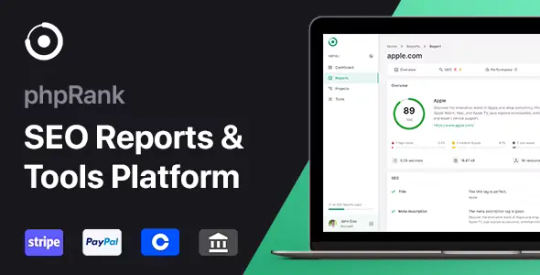
Unlock Powerful SEO Insights with phpRank Nulled Script Are you looking to supercharge your SEO reporting capabilities without breaking the bank? The phpRank Nulled Script offers a powerful and professional-grade SEO reporting platform that helps you deliver premium-level insights for websites of all sizes. Best of all, you can download it for free right here and start using it without restrictions! What is phpRank Nulled Script? The phpRank Nulled Script is a robust, easy-to-use SEO reporting tool built for marketers, developers, and business owners who want accurate and real-time website analysis. This script allows you to run a white-label SEO report platform directly from your own server, offering a seamless experience for users looking for in-depth insights into search engine visibility, performance metrics, and optimization recommendations. Technical Specifications Platform: PHP 7.x+ Database: MySQL 5.x+ Framework: Custom-built, lightweight PHP framework Responsive Design: Fully mobile-optimized layout Dependencies: cURL, GD Library, mod_rewrite Top Features and Benefits of phpRank Nulled Script Comprehensive SEO Reports: Get keyword rankings, meta information, social stats, and backlink profiles in a single report. White Labeling: Customize the platform with your branding and colors to offer a personalized client experience. Multiple SEO Tools: Includes SERP analysis, keyword density checker, backlink checker, and website speed analysis. Multi-Language Support: Reach global audiences with built-in multilingual compatibility. Automated Updates: Automatically fetch and display real-time data from trusted SEO sources. How phpRank Nulled Script Can Benefit You Whether you’re a digital agency, freelancer, or entrepreneur, the phpRank Nulled Script gives you the competitive edge you need. It not only simplifies the reporting process but also enhances the value you deliver to clients by offering precise, easy-to-understand metrics. With phpRank, your analysis will go beyond the surface, giving you access to the core data that drives search engine performance. Popular Use Cases SEO Agencies: Deliver white-label reports to clients under your brand. Freelancers: Offer one-time or recurring SEO audits as a service. Website Owners: Monitor your own site’s SEO performance regularly. Developers: Integrate the script into larger platforms or dashboards. Easy Installation and Setup Installing the phpRank is a breeze. Simply upload the files to your web hosting server, configure the database settings, and you’re ready to go. No advanced coding knowledge is required. The script comes with an intuitive setup wizard that guides you step-by-step through the process. Frequently Asked Questions Is phpRank Nulled Script safe to use? Yes, the nulled version available on our site is thoroughly scanned and tested. However, always ensure you are using it on a secure server with up-to-date configurations. Can I customize the script? Absolutely. The phpRank Nulled Script is built with developers in mind, allowing for full customization of both appearance and functionality. Does this script require a monthly subscription? No, once installed, it’s completely free to use. You won’t be tied to any recurring fees or licensing costs. Where can I download it? You can download the phpRank Nulled Script for free directly from our site. No registration or hidden charges! Download phpRank Nulled Script Today If you’re ready to unlock the full potential of SEO reporting, the phpRank is your go-to solution. Powerful, easy to use, and completely free—this script empowers you to take your SEO services to the next level. Also, if you’re looking for enhanced site protection, don’t miss out on the iThemes Security Pro NULLED. It's the perfect companion tool to safeguard your site against vulnerabilities. For multilingual optimization, check out the WPML pro NULLED plugin to translate your content efficiently and reach a broader audience.
Don’t wait—equip your digital toolkit with the phpRank today and start delivering top-tier SEO insights effortlessly!
0 notes
Text
Our fact-checker here got some of the facts egregiously wrong.
Let's start with the primary source: the FEC. This is the public campaign finance record being used to claim that the shooter donated to ActBlue:

It does say Pittsburgh; we do need to consider that. However, we do also need to note that it includes the zip code. Let's see what zip code 15102 refers to:

Bethel Park, PA, an outer suburb of Pittsburgh. That is also, let's be extremely clear about this, where Thomas Matthew Crooks lived. Not Bethel, PA. That's a very salient detail, because Bethel Park is only an hour's drive or so from Butler, and Bethel is several hours away.
Now Bethel Park is not Pittsburgh, and the FEC record does say Pittsburgh. But Bethel Park is still part of the Pittsburgh metro area, and it's common for Americans living in suburbs to give the core city as their city of residence when asked.
Now I'm not saying it was for sure the shooter who donated $15 to ActBlue in 2021, I want to be clear about that. As Ms. Brunner determined, there are other men named Thomas Crooks living in the Pittsburgh area, and it's possible one or more of them live in Bethel Park, and made that ActBlue donation. It is true that the shooter was 17 at the time of the donation, and may have needed help to make a donation (although I did have a visa debit card attached to my bank account when I was 17; that was how I paid for gas. You can make political donations via debit).
But a person can change a lot between 17 and 20, we still don't actually know his politics, and if he did donate, we don't know his motivations for doing so, nor do we know his motivations for registering as a Republican. Some leftists do that to vote in closed Republican primaries (such as those held in Pennsylvania).
It's important to get the details right, like Bethel Park vs Bethel, or that the FEC record includes zip code. Ms. Brunner was likely either being sloppy in her detective work or trying to discredit any possible narratives that the shooter was a leftist (a possibility we do need to consider). In this case the details don't help lend any more clarity than what has already been widely-reported.
It is too early to jump to conclusions about his motivations. All we know for sure is he was 20 and white.
Good news for American minorities: shooter was white
70K notes
·
View notes